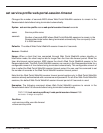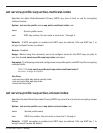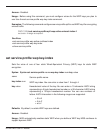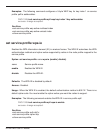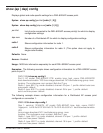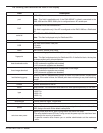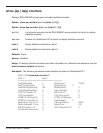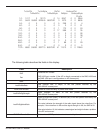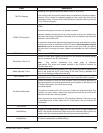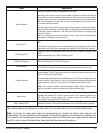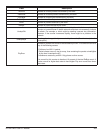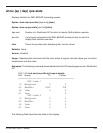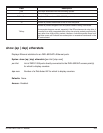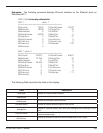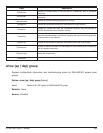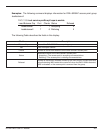
D-Link DWS-1008 CLI Manual 400
Field Description
TKIP Pkt Replays
Number of TKIP packets that were resent to the AP by a client.
A low value (under about one hundred) does not necessarily indicate a problem.
However, if this counter is increasing steadily or has a very high value (in the
hundreds or more), a Denial of Service (DoS) attack might be occurring. Contact
D-Link Technical Support.
CCMP Pkt Decrypt Err
Number of times a decryption error occurred with a packet encrypted with
CCMP.
Occasional decryption errors do not indicate a problem.
However, steadily increasing errors or a high number of errors can indicate that
data loss is occurring in the network. Generally, this is caused by a key mismatch
between a client and the AP.
To locate the client that is experiencing decryption errors (and therefore is likely
causing this counter to increment on the AP), use the show sessions network
session-id session-id command for each client on the radio. After you identify
the client that is causing the errors, disable and reenable the client (wireless
NIC).
CCMP Pkt Transfer Ct Total number of CCMP packets sent and received by the radio.
Radio Recv Phy Err Ct
Number of times radar caused packet errors. If this counter increments rapidly,
there is a problem in the RF environment.
Note: This counter increments only when radar is detected.
Rate-specific Phy errors are instead counted in the PhyError columns for
individual data rates.
Radio Adjusted Tx Pwr
Current power level set on the radio. If RF Auto-Tuning of power is enabled, this
value is the power set by RF Auto-Tuning. If RF Auto-Tuning is disabled, this
value is the statically configured power level.
802.3 Packet Tx Ct
Number of raw 802.3 packets transmitted by the radio. These are LocalTalk
(AppleTalk) frames. This counter increments only if LocalTalk traffic is present.
No Receive Descriptor
Number of packets for which the DWL-8220AP could not create a descriptor. A
descriptor describes a received packet’s size and its location in AP memory. The
AP buffers descriptors, and clears them during
interframe spaces.
This counter increments if the AP runs out of buffers for received packets. This
condition can occur when a noise burst temporarily floods the air and the AP
attempts to buffer the noise as packets.
Buffer overruns are normal while an AP is booting. However, if they occur over
an extended period of time when the AP is fully active, this can indicate RF
interference.
PktTxCount
Number of packets transmitted by the radio.
MultiPktDrop
Number of multicast packets dropped by the radio due to a buffer overflow on
the AP. This counter increments if there is too much multicast traffic or there is a
problem with the multicast packets. Normally, this counter should be 0.
MultiBytDrop
Number of multicast bytes dropped by the radio due to a buffer overflow on the
AP. (See the description for MultiPktDrop.)



